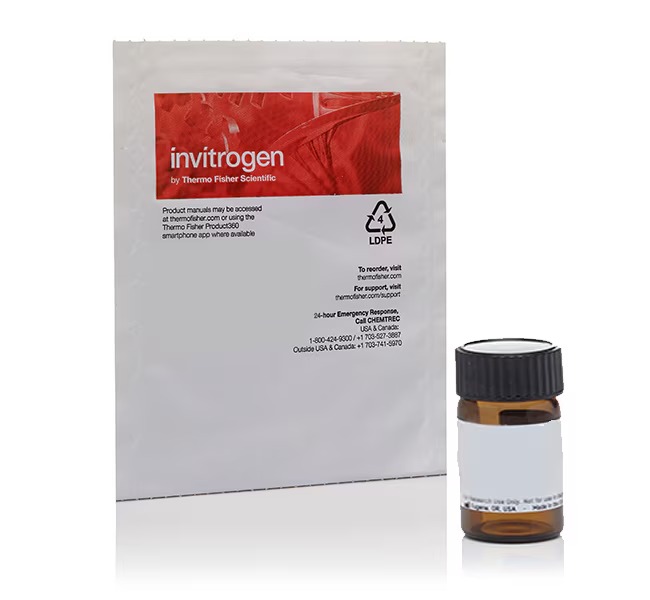Specifications:
| Application | Cell Analysis | ||
| Storage Temperature | 2-8°C | ||
| Product Type | Molecular Biology Reagent | Forms | Powder |
| Product Brand | Thermo Fisher Scientific™ | ||
| Product Grade | Molecular Biology | ||
The 2',7'-dichlorodihydrofluorescein diacetate (H2DCFDA), also known as dichlorofluorescin diacetate, is a cell-permeant indicator widely used to detect reactive oxygen species (ROS) in live cells. Its versatile applications include monitoring oxidative stress, detecting ROS intermediates, and studying cellular responses to environmental or physiological changes, such as ferroptosis.
Key Features
- ROS Detection:
- Sensitive detection of intracellular reactive oxygen species, including singlet oxygen, superoxide, hydroxyl radicals, and peroxides.
- Cell-Permeant Indicator:
- Easily enters cells, where intracellular esterases cleave acetate groups, and ROS oxidize the molecule to the fluorescent 2',7'-dichlorofluorescein (DCF).
- High Fluorescence Sensitivity:
- Detectable fluorescence with excitation/emission wavelengths of 492–495 nm/517–527 nm.
- Versatile Applications:
- Suitable for flow cytometry, fluorometry, fluorescence microscopy, and microplate reader analysis.
- Flexible Usage:
- Can be dissolved in DMSO, DMF, or ethanol for experimental applications.
- Enhanced Retention Versions:
- Modified variants (C400, C2938) with better cellular retention are available.
Specifications
| Parameter | Details |
|---|---|
| Product Type | ROS Indicator |
| Excitation/Emission | ∼492–495/517–527 nm |
| Quantity | 100 mg |
| Unit Size | 100 mg |
| Storage Conditions | Under dry argon or nitrogen; protect from air |
| Solubility | DMSO, DMF, or ethanol |
| Compatibility | Flow cytometer, fluorometer, microplate reader, fluorescence microscope |
| Applications | ROS detection, oxidative stress analysis, ferroptosis studies |
| For Research Use Only | Not for diagnostic procedures |
Applications
- Reactive Oxygen Species Detection:
- Study oxidative stress in live cells.
- Monitor reactive oxygen intermediates in immune cells like neutrophils and macrophages.
- Cell Death Mechanisms:
- Investigate ferroptosis and iron-dependent cell death mechanisms.
- Environmental and Physiological Studies:
- Examine cellular responses to oxidative environments.
- Fluorescent Analysis:
- Analyze ROS activity using advanced imaging and quantification techniques.
- Comparative ROS Studies:
- Utilize enhanced retention versions (C400, C2938) for longer-term cellular retention studies.
Advantages
| Feature | Benefit |
|---|---|
| High Sensitivity to ROS | Enables detection of subtle oxidative changes. |
| Cell-Permeant Design | Ensures effective cellular uptake. |
| Versatile Fluorescence Monitoring | Compatible with multiple analytical platforms. |
| Small Sample Size Compatibility | Suitable for various research scales. |
| Flexible Solubility Options | Can be dissolved in multiple solvents. |
| Enhanced Cellular Retention Variants | Ideal for prolonged ROS studies. |
Recommended Protocols
- Dissolve Indicator:
- Prepare H2DCFDA in DMSO, DMF, or ethanol at desired concentrations.
- Cell Loading:
- Incubate cells with H2DCFDA under optimized conditions.
- Follow literature-specific protocols for cell type and experimental needs.
- ROS Detection:
- Use compatible equipment:
- Flow cytometer for population-level analysis.
- Fluorometer or microplate reader for quantitative measurements.
- Fluorescence microscope for localized ROS visualization.
- Use compatible equipment:
Additional Products for ROS Research
- ROS Generation Reagents:
- For controlled ROS induction.
- Other ROS Indicators:
- Singlet oxygen, superoxide, hydroxyl radical, and peroxide-specific probes.
- Ferroptosis Research Tools:
- Comprehensive kits for studying iron-dependent cell death.
Competitor Comparison
| Feature | H2DCFDA | Competitor Products |
|---|---|---|
| Detection Sensitivity | High | Varies |
| Excitation/Emission Range | 492–495/517–527 nm | Comparable |
| Cellular Permeability | High | Variable, depending on product |
| Retention Variants Available | Yes (C400, C2938) | Limited |
| Versatility in Solvents | DMSO, DMF, ethanol | May require specific solvent preparations |
| Application Range | ROS, oxidative stress, ferroptosis | Typically limited to general ROS detection |
Comparison of H2DCFDA ROS Indicators Across Brands
| Feature | Invitrogen™ H2DCFDA | Abcam H2DCFDA | Sigma-Aldrich H2DCFDA | Cayman Chemical H2DCFDA | MedChemExpress H2DCFDA |
|---|---|---|---|---|---|
| Product Name | 2',7'-Dichlorodihydrofluorescein Diacetate | H2DCFDA | 2',7'-Dichlorodihydrofluorescein Diacetate | ROS Detection Cell-Based Assay Kit (DCFDA) | H2DCFDA (DCFH-DA) |
| Quantity | 100 mg | 25 mg | 50 mg | Kit format | 10 mg |
| Purity | High | High | Standard | High | High |
| Price Per Unit | Cost-effective for larger studies | Higher per mg | Moderate | Higher due to kit components | High for small-scale experiments |
| Packaging | Powder | Powder | Powder | Kit with additional reagents | Powder |
| Support | Extensive protocols and technical support | Comprehensive datasheets and guides | Standard technical support | Detailed instructions in kit form | Limited |
| Key Applications | ROS detection, oxidative stress analysis | General ROS detection | General ROS detection | Complete ROS assay in kit | Small-scale ROS detection |
| Fluorescence Properties | Ex/Em: 492–495/517–527 nm | Ex/Em: 492–495/517–527 nm | Ex/Em: 492–495/517–527 nm | Ex/Em: 492–495/517–527 nm | Ex/Em: 492–495/517–527 nm |
| Retention Variants | Available (C400, C2938) | Not available | Not available | Not available | Not available |
| Solvent Compatibility | DMSO, DMF, ethanol | DMSO, DMF | DMSO, ethanol | Pre-dissolved in kit | DMSO, ethanol |
| Advantages | High purity, large quantity, enhanced retention variants | Small-scale experiments, strong technical resources | Broad availability, moderate cost | Convenient all-in-one kit, complete assay setup | Ideal for small-scale experiments |
| Limitations | Requires optimization for some applications | Higher cost per mg | Standard quality, no enhanced variants | High cost, less flexible for custom assays | Small quantity, less flexibility |




 0
0
